
Gallery Photographers
Partner
Artists-in-Residence
Image City Feature Articles
Gary's Photographic Tips
Newsletter Archive
If you are unable to visit our gallery and would like to purchase photographs from this preview or others in the gallery, please contact the gallery and call 585-271-2540.
Peter Marr's Picks of the Show
Inspiration & Transformation
by JFK/AJVK, Richard Harvey & Betsy Phillips
with Joseph Sorrentino in the East Gallery
October 6 - October 31, 2010
Peter Marr picked his favorite photos from the show by the featured and guest photographers
and also describes the strength of the images he has chosen.
All images copyright by the individual photographers
Prints Like many great artists and painters, Richard is a visionary in the land of the frozen one-eyes. Contrary to what I normally do, I have chosen to comment on the collection of prints, rather than singling out one of them as a “Peter’s pick.” In using a fascinating blend of mixed media, digital processes, and photography as an aide-memoire, he has constructed superb, impressive images, which are refreshing in their originality. These prints are not only delightful to look at and admire, but they all challenge our objective vision. These images are works of distinction, pictures that have both philosophical and psychological implications, ones that provoke visual concern. The author’s exquisitely presented pieces; take us on a path of exploration of creativity, where imagination is paramount. The observer is given a passport to an unexplored world, where each image should invoke feelings which may trigger something very profound. Andre Breton, the principal founder of surrealism, stated that “It is through the power of images that, in time, real revolutions may well be brought about.” Here, we are not interested in changing life itself, but changing ways of seeing, and possibly to jar a viewer’s expectations of reality. What do you see? How do you see? Everybody sees people first, you look at people, or you deliberately don’t look. Nevertheless, if there is a face, then you cannot not look at it, and if there are strong eyes, you are drawn to them. Intuitively, all of Richard’s prints have a face with captivating eyes, and every time you look to explore, you see something different. Artists like him see more, because they are looking for more, and his assembled images are moving through time. In these mixed media prints, the eye can feel the different textures, marks, subtle colors, etc, elements that you cannot feel with a normal photograph. In these prints, I am constantly aware that the creativity we see comes from the heart, when the eye links to the hand, and the heart gives love. There is an intense desire to communicate at the non-verbal level. There is a tension between each image and what you want the image to do. I hope everyone who studies the author’s prints like I have done, will have the appreciation that they are truly memorable, a great credit to Richard’s artistic and visionary skills. Blood’s Stone Of all of the author’s wonderful thought- provoking images, this was the one that I found was the most fascinating. I especially liked the dark mat which really lifts this print, bringing out all of the drama and intensity of the vivid splashes of red and background color, in contrast to all of the black detail. One should certainly appreciate the impressive graphic design and powerful visual statement that this print makes, and laud the addition of the face from collaboration with Richard Harvey, which really lifts the entire image into the stellar category. In reflection of the observation that Richard Fahey made, namely “Perception is personal, we see what we see,” I offer two of my own personal thoughts of what this print says to me. The more obvious one, would be that we are experiencing the reconstruction of a tragic vehicular accident. The complex meanderings of tar –filled fissures, the end-result of cracks in the tarmac due to relentless winters and salt applications, intersect at the fatal accident point. The large volume of blood, the head injuries, and the saddened stream from the left eye, all indicate the seriousness of this tragedy. What I also visualize in this poignant image, are the disordered pathways of nerve fibers, where these axons are travelling to a nucleus along a living scaffolding. These journeys have been triggered from the sub-conscious, resulting from a serious adversity that happened in the past. The image of a loved one is clearly apparent at the axon nucleus site, the face injured and disfigured, and the deep red areas emphasizing the extent of the severe bleeding. Furthermore, we experience the pain and sorrow issuing from the left eye, flowing traumatically into the surrounding tissue. Sadly, the face has the highest light value, which probably means that the neural recollection of this person will always be a part of the sub-conscious, one that will transport any observer into the realm of visualization, inspiration and stimulation. Exit This outstanding print impressively illustrates the title of this exhibition, namely, “Inspiration and Transformation,” and it also exemplifies the author’s incredible vision and artistic excellence. In studying this print, I am reminded of what Wolfgang von Goethe so eloquently said, namely “The hardest thing to see is what is in front of our eyes,” or as I might put it, “It is not what you look at, it is what you see.” This memorable study, which Betsy told me was from a single exposure of a reflected image, is a powerful image in its own right, and it has a dreamlike quality that would thrill and absorb the attention of any viewer. It is important to remember that what we really see through our eyes and through the visual cortex is only about 50% of what we think we see. The other 50% comes from various areas of the brain, and is very dependent on our memory banks. This means that each of us see things differently, and although the eyes are the visual organs, it is the brain that sees. Another way of saying this, is that we are use to responding to what we think is there, but we don’t always see what really is there. The beauty of many reflected images, such as Exit, is that realism is disturbed, and conjecture and mystery often take over. I see the wavy vertical lines take on a musical, swaying motion, distorting reality in a very pleasing way. The exiting figures, however, seem to be standing still. The fingers in the upper center seem to be marching down to block the exit path, so maybe the people are correct in waiting before leaving. Whatever we think we see, we must have some concern for the large number of mostly yellow, diagonal lines that are present. Diagonals are powerful image vectors that demand attention. These lines create disturbances, not in keeping with the music flow or the exit path through the glass doors. Thus we promote the mystery element, and ponder whether the criss-crossed lines are barring our exit strategy, or encouraging us to leave as soon as possible. Transformation, whether in reality or in our brain is wonderful and compelling in the hands of a great artist like Betsy. This is an outstanding, moving image, and I would encourage every observer to not only look and admire, but to think creatively, as to what they imagine they are really seeing. All of Betsy’s incredible prints never fail to give one “Inspiration,” leaving each observer to make their own “Transformation,” to love and enjoy every image. She certainly makes the ordinary, extraordinary, as exemplified by her stunning prints on canvas, uniquely hung, giving a distinct third dimension. Seeing is life, that is the thrill. One is aware that there is a cognitive need to categorize and label, but especially in Betsy’s prints, one must use the imagination rather than the labels, to try and find out what the photographs emotionally say to you. In Lost, the eye is not directed to one particular area, but allowed to wander over a variety of shapes, colors and textures, each element supporting a strong feeling of intense tension and mystery. I see a complex network of irregular structures, reminiscent of an expanse of wire mesh, buried deep in the sub-structure, protecting the delicately colored, rich soil nutrients from the vagaries of deep frost and winter’s icy blasts. Above, the delicate root system of a large tree probes for vital sustenance, each finger meandering to and fro to find the easiest passage. Dramatically, this pathway has been blocked by a searing blast of early winter, blue, cold and menacing. If such an intrusion bodes of a severe freeze to come, the result in the Spring could be a tree stunted from malnutrition. The dilemma for the root system is to possibly change course to seek the clear path on the left hand side, or to wait for the blue ice to melt, allowing time for the roots to acquire adequate nourishment. Every observer will have their own interpretation of what they imagine or see in this lovely print. There certainly is excitement and mystery, it is ours to find, and we all thank the author most sincerely, for giving us such a wonderful, intriguing image. Train Depot The author has expressively captured the vitality, pastoral life and architecture of some of the more remote areas of Mexico. I particularly liked the way he has used the saturated, vibrant colors to great effect in some of the graphic design studies, and how he has cleverly used strong shadows so artistically as a telling visual element in many of the prints. I chose Train Depot to discuss further, because it is a good illustration of Joseph’s artistic skills, in blending strong colors, graphic design and compelling subject material into one delightful print. Most intriguingly and most interestingly, is that the vast majority of the colors that make up this dynamic image are in the red area of the spectrum. Certainly we have a sliver of blue sky, a sand-colored roadway, and a railway car with a light canvas top, all of which add powerful design elements to the image. It is the interplay of the structures and design features of the various red elements in contrast to the sky and roadway that makes this image so dramatic. One’s eye does repeatedly go back to the uplifted roof detail, because it is incongruous with the rest of the scene, but it is a small detail that the photographer could do nothing about. Ironically, this roof has the only diagonal structure in the print. The picture was creatively seen and captured. What could have been just a record shot, the author has elegantly composed the scene to give us a memorable photograph. 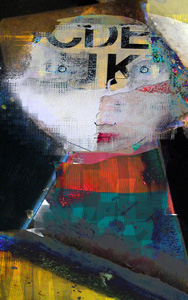
Mind Set 2
by Richard Harvey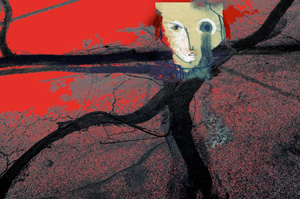
Blood's Stone
Collaboration with Richard Harvey
by JFK/AJVK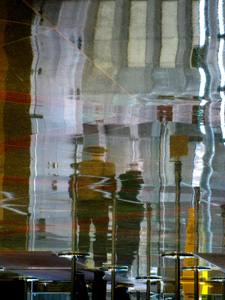
by Betsy Phillips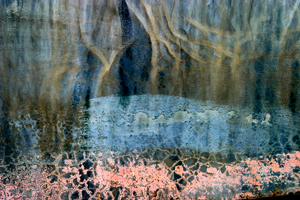
Lost
by Betsy Phillips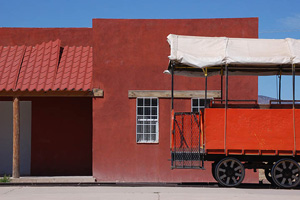
by Joseph Sorrentino
Image City Photography Gallery ♦ 722 University Avenue ♦ Rochester, NY 14607 ♦ 585.271.2540
In the heart of ARTWalk in the Neighborhood of the Arts